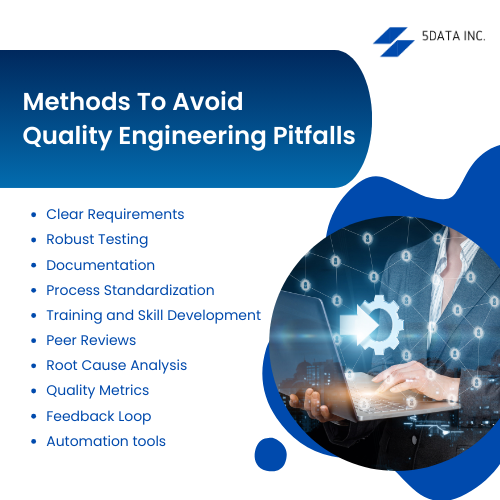What we cover in this blog
Quality Engineering
Quality Engineering is a discipline dedicated to guaranteeing that products and services consistently adhere to stringent standards of quality assurance and control. The software development industry involves managing, developing, operating, and maintaining IT systems and enterprise architectures to meet these standards. Modern data engineering practices that coordinate with the best application development services are leading organizations to use object stores more frequently, and this is happening because of the increasing scale and complexity of the data they manage and the expanding array of use cases requiring attention from these data warehouses. Data lakes on object stores are gaining popularity for storing unstructured data, covering a spectrum of machine learning and algorithm development through analytics and reporting. Studies have shown that approximately 80% of the data in any organization is unstructured. Storing and managing this unmatched amount and quality of data can be a significant challenge for many companies and organizations and can also be very costly.Common Mistakes In Quality Engineering
Common errors in quality control and management are frequent and can cause significant problems. These include not understanding recurring issues, failing to prevent known quality risks, making multiple copies of data during development, manually correcting errors, accepting subcontractor rework, lack of communication, not understanding the costs of rework, not prioritizing quality control, and compromising on data and quality control during development. Similarly, there are many pitfalls in both quality assurance and engineering. These include inadequate test coverage, insufficient collaboration between development and QA teams, relying solely on manual testing, neglecting performance testing, and overlooking the importance of continuous integration and deployment. It is crucial to address these areas to ensure robust software and quality assurance processes with the help of the best software application development company.- Incomplete Test Coverage: Failing to cover all aspects of the software can lead to undiscovered bugs. Ensure comprehensive testing across functional, non-functional, and edge cases.
- Lack of Collaboration: Poor communication and collaboration between development and QA teams not being on the same page can result in misunderstandings, leading to missed issues and delays in resolving defects.
- Over-Reliance on Manual Testing: Testing manually is time-consuming and prone to human error. Integrating automated testing helps increase efficiency and catch repetitive issues.
- Ignoring Performance Testing: Neglecting performance testing can lead to scalability and performance issues in production. It’s vital to assess how the software behaves under different loads and conditions.
- Neglecting Security Testing: In an era of frequent cyber threats, overlooking security testing can leave vulnerabilities unaddressed. Regularly check for security loopholes to protect sensitive data.
- Inadequate Test Data Management: Improper handling and organization of test data can result in inaccurate testing outcomes. Establishing robust test data and quality management organization and system strategy is essential for consistent and reliable testing.
- Not Embracing Test Automation: Failing to adopt test automation where applicable can hinder the speed of testing and increase the likelihood of missing defects, especially in regression testing scenarios.
- Absence of Continuous Integration/Continuous Deployment (CI/CD): Without CI/CD pipelines, delays in code integration and deployment can occur, impacting the speed and efficiency of delivering software updates.
- Insufficient Regression Testing: Overlooking regression testing after code changes can introduce new defects. Regularly execute regression tests to ensure that existing functionalities remain unaffected.
- Neglecting Usability Testing: Ignoring the user experience can lead companies to dissatisfied customers and users. Incorporate usability testing to assess how easily users can interact with the software and identify areas for improvement.

Methods To Avoid Quality Engineering Pitfalls
When moving to data lakes, ensuring data quality becomes a new challenge over time. The overall reliability of the data lake depends on the quality of the data that is introduced. The quality management system at the data ingestion stage is a critical component responsible for ensuring the soundness of the service and data. Object-based storage systems have become a popular solution for archiving, backup, and storing static content through application development services. They are easy to use and offer several benefits. Despite the assumption that large volumes of data will not be stored well, object storage ensures high quality through a data lake model, and this is why the data lake model is becoming increasingly popular. In summary, object storage is the preferred option for managing static data. To minimize mistakes in the production process and quality engineering challenges related to the quality of data within the data lake: 1. Clear Requirements: Prioritize a comprehensive understanding of project requirements and costs before commencing and demonstrate effective communication with stakeholders and customers. 2. Robust Testing: Implement comprehensive testing procedures to identify issues early in the development and production process. 3. Documentation: Maintain detailed documentation for all aspects of the project, facilitating easy tracking, documentation, and analysis of changes. 4. Process Standardization: Establish and follow standardized processes to create consistency and better results and reduce the likelihood of engineering errors and mistakes. 5. Training and Skill Development: Invest in continuous training for team members to improve their expertise and stay current on industry best practices in performing their jobs. 6. Peer Reviews: Conduct regular peer reviews to have a fresh set of eyes to identify potential mistakes in construction projects or areas for improvement in construction projects. 7. Root Cause Analysis: Investigate and address the root causes of any identified issues rather than just fixing symptoms. 8. Quality Metrics: Define and monitor key quality metrics to gauge the effectiveness of your processes and identify areas for improvement. 9. Feedback Loop: Encourage open communication and feedback from other stakeholders within the team, fostering a culture of continuous improvement. 10. Automation tools: Implement automation tools where possible to reduce human error and increase efficiency in repetitive tasks.Conclusion
Data QA engineers and data scientists should always test newly ingested data continuously and confirm that they meet all the required quality assurance standards. This process is similar to how software QA engineers apply automatic testing to new code. Data scientists should create a way to reproduce errors and roll back to a previous high-quality snapshot of their data to prevent errors from propagating throughout the system. Avoiding quality engineering pitfalls common to engineering mistakes and an ongoing process that involves the right balance of effective communication, robust processes and guidelines, and a commitment to learning and improvement.
About the Author...
Aparna Sushumna, a mother to a hyperactive toddler who is all over the house. I aspire to be a decent content developer. A Bachelorette of technology says my qualification but I anticipated being a singer. Thanks to the recession, I dwelled into various jobs, from coding to being a tech support executive to a help desk professional, only to conclude that there is something else I wish to do. Here I am to accomplish my profound passion for content writing. Music, nature, jewelry, beauty, mythology, life quotes, celebs, and their life, being my areas of interest.
